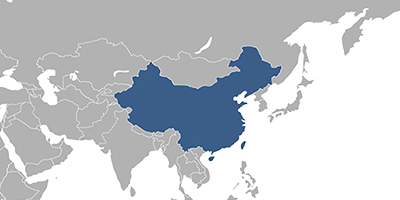China

International Country Code:
CNTime Zone:
UTC/GMT +08:00Currency:
Chinese Yuan Renminbi (CNY)PCT national phase entry in China
PCT national phase entry in China
- Patent fees
Fees associated with Chinese PCT national phase entry, as well as other patent fees, are available in the fee calculator.
- Deadline for PCT national phase entry in China
The term of filing a patent application in China based on the PCT is 30 months from the date of priority. The term may be extended for two additional months.
- Filing requirements in China
The official language is Chinese. If patent application materials are filed in another language, a translation into Chinese must be provided to CNIPA before the expiration of the 30-month term from the priority date (or 32 months with the extension).
To enter PCT national phase in China, an application should contain:
- applicant’s and inventor’s details;
- international application number and application materials.
A simply signed copy of the Power of Attorney should be provided within three months from the national phase entry.
It is not necessary to provide the Assignment Deed between applicant(s) and inventor(s) when entering PCT national phase.
- Examination of a PCT national phase patent application in China
Patent applications in China undergo formal and substantive examinations. A request to conduct substantive examination must be filed within three years from the international filing date or, if priority is claimed, from the priority date.
- Novelty grace period
The disclosure of information about an invention within six months prior to the international filing date in China does not disprove its novelty if:
- the disclosure has occurred for the purpose of public interests in the case of national emergency;
- it is first exhibited at an international exhibition sponsored or recognized by the Chinese Government;
- it is first made public at a prescribed academic or technological meeting;
- it is disclosed by any person without the consent of the applicant.
- Grant, validity term and maintenance fees
Patents in China are in force for twenty years from the international filing date. The first annual fee is to be paid at registration. All subsequent annual fees should be paid in advance before the anniversary of the international filing date. Late payment is possible within a six-month grace period by paying a corresponding surcharge.
- Duration of registration procedure
The average processing time for patent registration procedure in China is 3 years.
- Utility Model
Inventions may also be protected as Utility Models in China, which are subject to formal examination only. However, conversion of a patent application into a utility model and vice versa is not possible.
Utility Models in China shall be granted for new and practical technical solutions relating to the shape and/or structure of a product or the combination thereof, which are fit for practical use.
The maximum protection period of a utility model in China is ten years from the international filing date.
- Representation by a patent attorney
Foreign applicants who wish to perform national phase entry in China must appoint an agent, a Chinese patent attorney officially registered before the China National Intellectual Property Administration.
- Notes
1. Online Database for Chinese Patent and Utility Model Search.
2. It is possible to validate Chinese invention patents (not utility models and design patents) in Cambodia, providing that they have the filing date after January 22, 2003 and are granted in good order. Duration of the validated patents is 20 years from the filing date of the corresponding Chinese application, meaning that such patents have legal force in Cambodia for the rest of the term of the corresponding Chinese patents.
Brief summary is based on the information provided by Borsam Intellectual Property on 13.02.2025
Please contact us if the above information is not in conformity with Chinese IP Laws